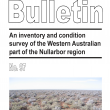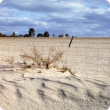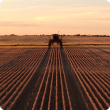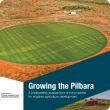Crops
The Department of Primary Industries and Regional Development continues to support the growth and international competitiveness of all crop industries in Western Australia.
With a 2400 kilometre span from its tropical north to its temperate south, WA supports a broad range of cropping industries from rain-fed winter cereals through to irrigated horticultural crops.
In the 2012/13 year the WA cropping industries exported a total of $3.9 billion which comprised: $3.1 billion of cereals, $859 million of pulses, pastures and oilseeds, $142 million of horticultural crops. The major contributors to these exports were wheat ($2.7 billion), canola ($756 million), barley ($377 million), lupins ($42 million), carrots at $48 million, oats ($12 million), and strawberries at $5.5 million.
Filter by search
Filter by topic
- Climate, land & water (113) Apply Climate, land & water filter
- (-) Remove Soils filter Soils
- Managing soils (73) Apply Managing soils filter
- Grains (63) Apply Grains filter
- Production & postharvest (32) Apply Production & postharvest filter
- Soil management (29) Apply Soil management filter
- Pastures (24) Apply Pastures filter
- Land use (24) Apply Land use filter
- Resource assessment (23) Apply Resource assessment filter
- Soil acidity (22) Apply Soil acidity filter
- Measuring and assessing soils (21) Apply Measuring and assessing soils filter
- Grains research & development (21) Apply Grains research & development filter
- Soil constraints (19) Apply Soil constraints filter
- Soil nutrients (15) Apply Soil nutrients filter
- Wheat (14) Apply Wheat filter
- Soil salinity (14) Apply Soil salinity filter
- Water repellence (12) Apply Water repellence filter
- Waterlogging (12) Apply Waterlogging filter
- Water (12) Apply Water filter
- Liming (12) Apply Liming filter
- Livestock & animals (12) Apply Livestock & animals filter
- Climate & weather (9) Apply Climate & weather filter
- Canola (8) Apply Canola filter
- Lupins (7) Apply Lupins filter
- Pasture management (7) Apply Pasture management filter
- Horticulture (7) Apply Horticulture filter
- Barley (7) Apply Barley filter
- Rangelands (6) Apply Rangelands filter
- Pulses (6) Apply Pulses filter
- Soil compaction (6) Apply Soil compaction filter
- Livestock management (6) Apply Livestock management filter
- High rainfall pastures (6) Apply High rainfall pastures filter
- Land use planning (5) Apply Land use planning filter
- Plant nutrition (5) Apply Plant nutrition filter
- Climate change (5) Apply Climate change filter
- Assessment for agricultural expansion (5) Apply Assessment for agricultural expansion filter
- Pasture species (4) Apply Pasture species filter
- Soil carbon (4) Apply Soil carbon filter
- Irrigated crops (4) Apply Irrigated crops filter
- Field peas (4) Apply Field peas filter
- Water erosion (3) Apply Water erosion filter
- Water management (3) Apply Water management filter
- Vegetables (3) Apply Vegetables filter
- Pests, weeds & diseases (3) Apply Pests, weeds & diseases filter
- Fertiliser (3) Apply Fertiliser filter
- New horticulture crops (3) Apply New horticulture crops filter
- Fire (2) Apply Fire filter
- Carbon farming (2) Apply Carbon farming filter
- Crop weeds (2) Apply Crop weeds filter











